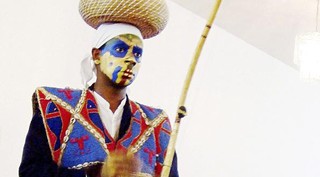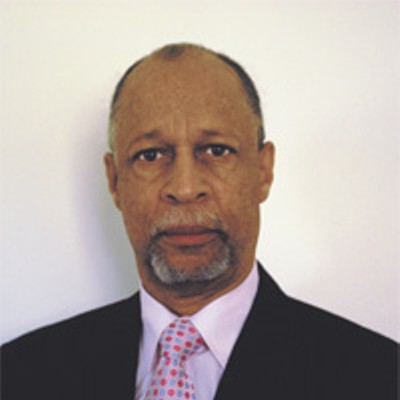Sundays might happen once a week, but the process of documenting church services across the city was a project more than a decade in the making for local professor Ja Jahannes, whose exhibit Sunday in Savannah opened at the Beach Institute last week.
For Jahannes, who taught behavioral analysis and psychology, the project was a personal passion rather than an academic pursuit.
The inspiration first struck about 16 years ago when Jahannes, who is also recently retired as minister at Abyssinia Baptist Church, was invited to take part in a service at the Royal Church of Christ. While there, he saw an 80 year old woman playing the washboard, something he hadn’t seen since his childhood.
“There are some practices in these churches that are dying out,” he says. “I thought someone needed to document that.”
The task proved much more difficult than simply pressing a button on a camera though.
At first, Jahannes approached his friend, local photo legend Jack Leigh, about collaborating on the project, with Leigh behind the lens and Jahannes researching the cultural and anthropological sides.
“Jack thought it was a great idea, and we’d talk about it every six months, but it never went anywhere because he had his own projects,” remembers Jahannes.
He then tried to recruit the talent of his wife, photographer Clara AgÜero, who didn’t assist with shooting, but later helped curate what has become Sunday in Savannah, choosing the most telling of more than 1,500 photos taken by Jahannes over a nine month period in 2007.
While not every photo is of impeccable quality to the discerning eye, even those that are slightly blurred or grainy capture the energy and passion of the moment, and the body of work as a whole undoubtedly accomplishes Jahannes' goal of creating a visual document of the city’s church culture and traditions.
“My intent with the whole presentation was for individuals to learn another way of documenting and preserving their heritage for today’s generation and tomorrow’s,” explains Jahannes. “I didn’t intend to become a photographer.”
To capture the culture visually – from the dramatic, colorful attire to the stoic architecture – helps make it more accessible to people, harkening back to the old adage a picture is worth 1,000 words. It is faster and more approachable to document something like this photographically than it is to try and translate the history and significance of a practice through words.
“It’s a lot easier to look at photographs with explanations of them than to talk about we did this in this year and that in that year,” says Jahannes. “The photo–documentary process is really suited for this.”
Jahannes had one particular advantage over more experienced shutterbugs who’ve tried to capture similar subject matter – his experience as a minister allowed him to move around during church services without disturbing the ceremonies or congregation members.
“Being a minister myself, I do know how to move about during those sacred parts of the service without disturbing them,” he explains.
His insider knowledge pays remarkable dividends when it comes to the subject matter.
The show demonstrates an incredible range from quiet, spiritually intimate moments – like “Solemn Prayer” wherein a 99 year old parishioner sits alone in a pew, head bowed – to the boisterous passion and praise that are the hallmark of so many traditionally African American churches in the South – and evident in the photo “Bringin’ Down the House,” a close up shot of Sister Barbara Pinkney in the midst of belting out a powerful song with the congregation behind her frozen in poses of praise and exultation.
Whether its candidness of the photos’ subject matter, or the post–reality–TV skepticism of the 21st Century, the easy assumption is that many of the shots were posed, but Jahannes says that he set out to capture people and places as they were without interfering.
“I had made it a dictum in my mind that I wouldn’t take any posed pictures,” he says.
There is an exception to every rule, however, and one posed image did make it into the exhibit.
“Out of all the images that I took, there was only one image that was actually posed,” Jahannes says. “A little boy saw that I was taking pictures and he posed. He was very confident in himself. That’s what church is for for the young people.”
Intermingled with the shots of church–goers are the structures themselves – exterior shots of several local churches that show how places of worship are as architecturally diverse as the people and practices within them.
In one particularly telling juxtaposition, a shot of the very traditional looking church of St. Philip Monumental A.M.E. hangs next to an image of the more modern façade of the Resurrection of our Lord Catholic Church.
Even after shooting more than 1,500 images, Jahannes doesn’t see himself as a photographer.
“In terms of the history and the culture, they’re not the world’s best photographs, but it’s certainly worth noting the church,” he says.
For him, the goal of the project was not to create an exhibit of fine art, but to document the city’s unique church culture so that it can be preserved for future generations.
“Savannah is a deeply religious community,” says Jahannes. “The church really is a major repository of the culture – spiritual culture, historical culture, material culture and social culture.”
His decision to take matters – and a camera – into his own hands stemmed from the imperative to document traditions that may be fading.
“The lady I told you about that excited the whole project, the next time I was invited back to that church she was deceased,” he says, explaining why the woman with the washboard who inspired the project does not appear in the exhibit.
In her place is a photo of man in his 60s holding the washboard, and although he readily admits it’s not the strongest photo in the series – it was important for him to have the image in the show because of its greater meaning to the project as a whole.
If you walk around Savannah on a Sunday morning and see congregations coming and going, the scenes Jahannes has captured may seem, on the surface, like average weekly occurrences; but they are more fragile than they might appear.
In the age of mega–churches and broadcast evangelists, the act of worship is changing all over the world, but as with most things in Savannah, change is slow to arrive. In this case, that’s a blessing.
Sunday in Savannah
Where: Beach Institute, 502 E. Harris St.
When: Through August 15
Info: www.kingtisdell.org, (912) 234-8000



























